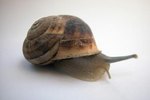
You won't find a radula anywhere in the human body, but it's a common anatomical feature among animal species in phylum Mollusca. Biologists describe it as a rasping dental ribbon that replaces the tongue found in mammals. Oysters, clams and other bivalves are the only mollusks that lack this organ.
Tough as Nails
While the radula serves a similar purpose as the tongue of many other animals, there are some key differences. Unlike the soft and fleshy organ in the human mouth, radulas are made out of a hard material called chitin. On the molecular level, chitin is composed of a nitrogen group connected to a cellulose polymer, according to the Tulane University Biology Department. It is the same material found in the hard exoskeletons of various creatures as well as in the cells of fungal species.
Mouth Full of Teeth
Radula are often compared to chainsaws, because they are covered by hundreds of tiny teeth that are organized into rows. Herbivorous mollusks can have up to 25,000 teeth on this tiny organ, while carnivorous species tend to have fewer and larger teeth, according Cabrillo Community College Biology Department. The inside of the radula is a tube of cartilage, which gives the dental ribbon structure so it can create friction against surfaces it touches. Radula vary in length according to the species. Some are less than a millimeter long, while those of larger species are much longer.
Form Fits Function
The radula of each mollusk species is adapted to fit the dietary needs of the species. Chitons and other herbivorous species have a flat radula covered in very tiny teeth, which makes it the perfect tool for harvesting algae growing on rocks in the water. The radulas of carnivorous moon snails are designed to drill through the hard shells of clams and other prey. Squid and other larger creatures use their radula to break food into smaller pieces after biting a chunk of flesh from their prey with their large beak. The mollusk's radula constantly grows from a base deep within the animal's body. This process replaces tissue at the tip as it's worn away from use.
Lethal Injection
While most mollusks use their radula to rasp, chew or bore holes, some species have developed more devious applications for their peculiar dental organ. Cone shells (Conidae spp.) are carnivorous snails. Their radula is equipped with only a single tooth at a time. It stores backup teeth in a holding sac so it can immediately replace the lone tooth after each use, according to the Living World of Molluscs. The radula apparatus functions as a barbed harpoon that injects venom into the snail's prey. The venom is a paralyzing toxin made from amino acids within the snail's body.
References
Photo Credits
-
Comstock/Stockbyte/Getty Images
Writer Bio
Quentin Coleman has written for various publications, including All Pet News and Safe to Work Australia. He spent more tan 10 years nursing kittens, treating sick animals and domesticating semi-feral cats for a local animal shelter. He graduated from the University of Delaware with a bachelor's degree in journalism.




